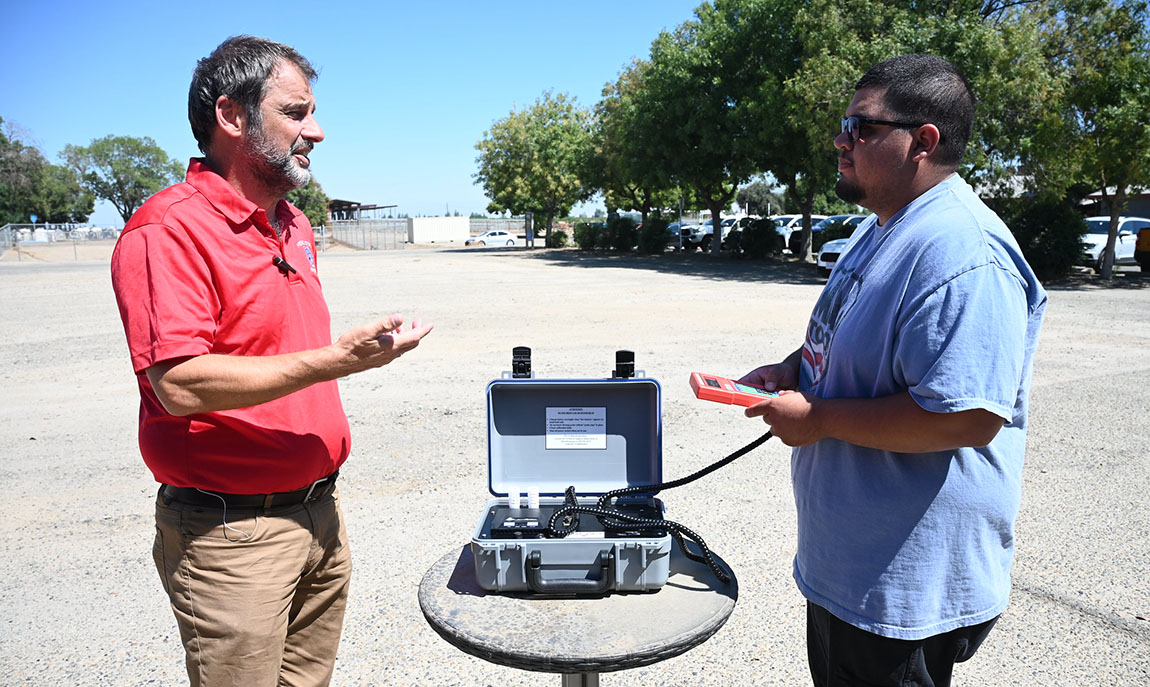The Jordan College of Agricultural Sciences and Technology
IT Emissions Program

When he was thirteen years old, Fresno State staff member Chris Fuentes remembers visiting his father, David Fuentes, while he worked as a diesel mechanic at FTL Trailer and Refrigeration Repair.
“There wasn’t a lot to do,” Fuentes said, “besides, throwing away old tires, or taking care of the grass and weeds. But for me, it was exciting and a little scary being around all the big trucks.”
The allure only increased as he got older. His grandfather and uncles were also mechanics, and when Fuentes took a small engine course in high school, it made sense as a career after he graduated from Selma High School.
He started working as a Tire and Lube technician at Walmart, Tire service technician for Goodyear Commercial Tire and a Freightliner semitruck dealership. The latter location encouraged him to take classes at Fresno City College to get his heavy truck mechanic’s certification, which he received in 2020.
Now this experience is helping him play an important role managing the future of California semitrucks.
The Selma native was hired on campus in August 2023 to work with Fresno State Industrial Technology faculty Dr. Athanasios Alexandrou to oversee a new state emissions referee testing station on campus for non-gasoline on-road heavy-duty vehicles with a gross vehicle weight rating greater than 14,000 pounds. The station is part of the Clean Truck Check program also known as Heavy-Duty Inspection and Maintenance (HD I/M) Referee program, established by the California Air Resources Board (CARB).
Fuentes will oversee the testing site near the northwest corner of Barstow and Chestnut, in the vicinity of the campus dairy. His evaluation includes a visual inspection, on-board diagnostics computer scan and tailpipe exhaust collection. An additional smoke opacity test is required for older vehicles without on-board diagnostic equipment, which became common in 2013.
The testing site is one of the first two in the California Air Resources Board's Clean Truck Check Referee program (more stations will be added later), which aims to reduce smog-forming and carcinogenic toxic air and meet federal healthy air mandates. Starting in 2024, semi truck inspections and tests of California operating vehicles will be required twice a year for semi trucks over 14,000 pounds. On-road agricultural vehicles and California-registered motorhomes will be inspected once per year.
Trucking is a key part of the nation’s leading agricultural area, and this campus location aligns with shipping routes for Central Valley growers, producers and manufacturers.
“Most trucks come with computers where data is being collected, so operators may already know of these issues and fault codes on their vehicles,” Fuentes said. “Some of these engines can go up to a million miles if they’re taken care of, and that can make a difference in keeping harmful emissions down. Staying updated with preventive maintenance intervals, routinely vehicle inspections and fixing fault codes with the trucks is already good practices and emissions-reducing.”
CARB will soon begin sending testing notices to trucking operators, who can also use independent, Heavy Duty Inspection Maintenance-certified testers for emissions certifications. This method might be at more conveniently located facilities, and HD I/M testers can even travel to truck operators for tests with the proper equipment.
Trucks that were built in 2013 or more recently can potentially even use their on-board diagnostics (OBD) equipment to gather required emissions data and upload it to the CARB system to verify compliance.
If trucks fail any part of the emission test, equipment maintenance is required. Fuentes will then oversee a retest after or can verify proper follow-up functionality with independent testers.
Tests will need to be arranged in advance by using an online application, and some vehicles have already been tested at random, high-traffic roadside locations this year in the first stages of program implementation.
This year, Fuentes started receiving training from the CARB parent testing officials. A similar site at UC Riverside began testing semi trucks earlier in 2023, which is managed by its Center for Environmental Research and Technology.
The $50 million, state program originated from a Senate Bill passed in 2019 (210, Chapter 298) and includes $3 million of emissions funding each year. The state’s emphasis on lower heavy-duty vehicle emissions is part of additional laws expecting fleets to gradually transition toward electric-powered vehicles.
Air quality in various parts locally and around the state are often rated among the nation’s worst on average by the American Lung Association.
Heavy-duty vehicles continue to be major contributors even though they make up only a small portion of vehicle users. In 2020, CARB estimated that heavy-duty vehicles accounted for about 52 percent of the state’s on-road nitrogen oxide emissions and about 54 percent of its on-road, fine particulate micron emissions, otherwise known as PM2.5.
CARB field testing of heavy-duty vehicles is expected to help, especially since their data has shown approximately 11 to 17 percent of vehicles with on-board diagnostics already have indicator lights exposing malfunctions.
Based on state projections, the program hopes emissions reductions will improve air quality and potentially avoid approximately 7,500 premature deaths and 6,000 hospitalizations statewide for $75.8 billion in health benefit from 2023-2050.
Tests could be required up to four times a year by 2027, to receive a valid compliance certificate tied to their DMV vehicle registration. Potential expansion of other testing locations at Fresno City College or other San Joaquin Valley higher education institutions or locations is a possibility, depending on the demand and available funding.
“I’ve always loved working on trucks,” Fuentes said, “and I’ve enjoyed the satisfaction of helping drivers get their trucks running properly so they can be back on the road where they want to be. This is a new way that helps make the flow of products to our stores and communities more sustainable.”